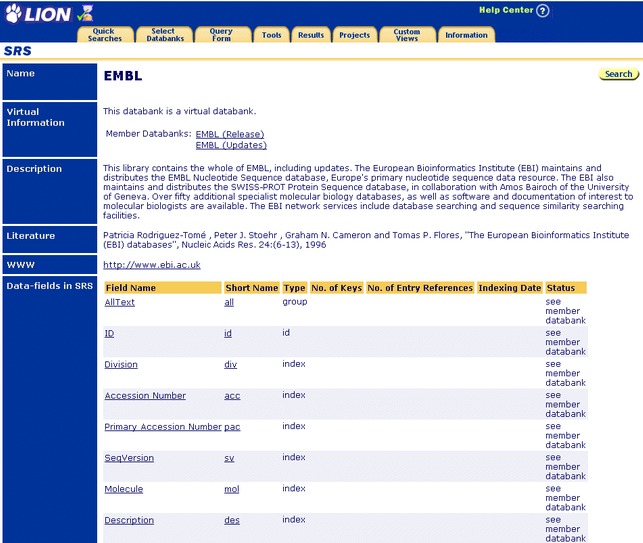Information Pages - Databank Information
Databank Information
| What are loaders and what are they used for? |
| What is the Links information about? |
| What is the SRS Description? |
More about the Databank Information page.
See also section "Getting to the Field Information Page" in chapter 3, "Querying with SRS", of the SRS User Guide for more information on this page.
Databank Information Page - FAQs
What are Loaders and What are They Used For?
A loader is a construct which facilitates the conversion of SRS databank entry information (which often differs from one databank to another) from the raw databank format into a standardized format which is then used by SRS to display the data, i.e. they control what is displayed in the various predefined views and entry used within SRS, e.g. SeqSimpleView, SwissView SwissEntry.
Clicking on one of the hyperlinks will display the Loader Information page for that loader, enabling you to find out more about that loader.
What is the Links Information About?
The links listed on the Databank information page tell you more about which databanks have explicit links to/from your selected databank. There is also information, such as how many links there are between the your databank and each databank in the link list and when the databank was indexed.
More about Links.
What is the SRS Description?
The links here allow you to view some of the files used to control the way the information in the databank is accessed. They are not normally relevant to most users unless they are also involved in databank administration.
Databank Information Page - Reference

Figure 7.1 Databank Information page.
Getting to the Databank Information Page
This page can be reached by clicking the name hyperlink of the databank in question, e.g. from the Select Databanks to Search page or from the List of Databanks page.
Databank Information
This page lists information about the chosen databank. Headings describing the nature of the data are listed on the left. Some of the common data headings are described below.
Name
This is the name of the databank, e.g., EMBL, SWISS-PROT.
Virtual Information
This indicates whether the databank is a virtual one, and lists the databanks that make up the virtual databank.
Status
This is the current status of the databank, e.g., the number of entries, the indexing date, etc.
Description
This section contains a brief description of the databank. This is useful to help determine whether the databank is likely to be of interest.
Literature
This contains references to any journals that have been written about the databank.
WWW
This is the URL of the home page for the databank.
FTP
This contains URLs from which the databank files can be downloaded using FTP.
Data-Fields in SRS
This is a list of the datafields that are available for the databank. They are presented in the form of a table. Each row represents a datafield. The data for each datafield are listed under column headings.
- Name
- This is the name of the field. It also represents a hyperlink to the Field Information page.
- Short Name
- This is the short name (two or three characters) for the datafield. You will see it used to represent the datafield in code or in the table of results for a query when use short name is selected in the view definition. It also represents a hyperlink to the Field Information page.
- Type
- This identifies the type of information found in the datafield.
- No of Keys
- This is the number of entries that are indexed to the datafield.
- No of Entry References
- This is the number of entries that have a reference to the datafield index.
- Indexing Date
- This is the date on which the datafield was last indexed.
- Status
- This is the current status of the datafield index.
Loaders
This section contains links to some the Loader Information page for the relevant tool loaders.
See also: What are Loaders and What are They Used For?
Links
This table contains information about links between the current databank and other databanks. The data in each row of the table are subdivided into categories.
- From Databank
- This is the source databank.
- Entries Linked
- This is the number of entries that have links directly from the source databank (From Databank) to the search databank (To Databank).
- To Databank
- This is the search databank. SRS checks this databank to see whether there are any entries that should have a link included in the index because they meet the criteria for a link to be established.
- Entries Linked
- This is the number of entries that have direct links from the To Databank back to the From Databank.
- Links Total
- This is the total number of links between the two databanks.
- Indexing Date
- This is the date on which the link index was created.
SRS Description
This section contains hyperlinks to the databank module and SRS configuration files that are used for this databank.
Search
The  button takes you to your default Query Form where you can start a query on the databank whose databank page you are on. This may be either the Standard Query Form or the Extended Query Form depending on your current default settings.
button takes you to your default Query Form where you can start a query on the databank whose databank page you are on. This may be either the Standard Query Form or the Extended Query Form depending on your current default settings.
Other Information
